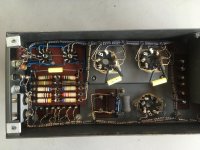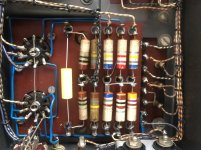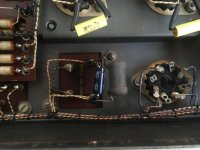I have two Quad II amplifiers which I got from a lovely man called Phillip Knighton in Wellington many years ago, and which I have not used for a long time. I was going to go and see him and ask if he could check them over, but I discovered with sadness that he is no longer with us, so I went ahead and tried them. One is fine, but the other does not work - one KT66 does not glow and it makes no sound. I have swapped over valves from the working unit and the result is the same. Phillip had replaced some capacitors (not the smoothing caps) but the resistors are original. Is it worth replacing the resistors (I am not worried about losing originality - I just want a working amp) or is there anything I can check with a multimeter to find the problem?
Attachments
You could at least check the heater voltage on the tube that doesn't glow.
If there is no heater voltage, trace it from the transformer to see if there's a wire broken on its way to the tube socket (or the socket is broken) or a solder joint opened.
Since you swapped tubes already, overwhelming probability is that this is the cause.
At the transformer you have heater voltage, otherwise the other tubes wouldn't glow. Somewhere along the way to that particular tube pins, it got lost.
A bit of logic goes a long way here.
Jan
If there is no heater voltage, trace it from the transformer to see if there's a wire broken on its way to the tube socket (or the socket is broken) or a solder joint opened.
Since you swapped tubes already, overwhelming probability is that this is the cause.
At the transformer you have heater voltage, otherwise the other tubes wouldn't glow. Somewhere along the way to that particular tube pins, it got lost.
A bit of logic goes a long way here.
Jan
Last edited:
Don't start replacing component before the cause of failure is known and repaired. In fact every haphazard component change will make troubleshooting more difficult and the total repair more costly.I have two Quad II amplifiers which I got from a lovely man called Phillip Knighton in Wellington many years ago, and which I have not used for a long time. I was going to go and see him and ask if he could check them over, but I discovered with sadness that he is no longer with us, so I went ahead and tried them. One is fine, but the other does not work - one KT66 does not glow and it makes no sound. I have swapped over valves from the working unit and the result is the same. Phillip had replaced some capacitors (not the smoothing caps) but the resistors are original. Is it worth replacing the resistors (I am not worried about losing originality - I just want a working amp) or is there anything I can check with a multimeter to find the problem?
If you don't feel competent to diagnose and fix the amp i suggest you seek out a repair shop.
Absolutely - I don't want to replace anything unnecessarily, and I'm not looking for improvement (apart from a state of not functioning to one of working properly) I am competent to take measurements within the limits of my multimeter and make observations within the limits of my eyes and ears - I just need advice and direction in order to arrive at a diagnosis, and I would be very interested to be more of a part of that process than just the person who pays the bill! I like these amps, and would like to understand them better.
Is there a small tube that does not glow? That could mute the sound.
If you haven't yet, swap the small tubes to check for a bad one.
Of course, a bad filament wiring connection could cause a good tube not to glow.
If you have no one local to ask, next measure all the resistors when unpowered.
But I would not replace any parts until the actual problem is found.
If you haven't yet, swap the small tubes to check for a bad one.
Of course, a bad filament wiring connection could cause a good tube not to glow.
If you have no one local to ask, next measure all the resistors when unpowered.
But I would not replace any parts until the actual problem is found.
Last edited:
I have two Quad II amplifiers which I got from a lovely man called Phillip Knighton in Wellington many years ago, and which I have not used for a long time. I was going to go and see him and ask if he could check them over, but I discovered with sadness that he is no longer with us, so I went ahead and tried them. One is fine, but the other does not work - one KT66 does not glow and it makes no sound. I have swapped over valves from the working unit and the result is the same. Phillip had replaced some capacitors (not the smoothing caps) but the resistors are original. Is it worth replacing the resistors (I am not worried about losing originality - I just want a working amp) or is there anything I can check with a multimeter to find the problem?
A good start is to compare voltages ( AC and DC ) with the schematics.Absolutely - I don't want to replace anything unnecessarily, and I'm not looking for improvement (apart from a state of not functioning to one of working properly) I am competent to take measurements within the limits of my multimeter and make observations within the limits of my eyes and ears - I just need advice and direction in order to arrive at a diagnosis, and I would be very interested to be more of a part of that process than just the person who pays the bill! I like these amps, and would like to understand them better.
As stated the some tubes "does not glow" indicated that filament power might
be missing, check that first.
Please could you provide a list of DC voltages for all tube pins, for each valve and list them here? The larger octal sockets - start at the pip and count clockwise from that (looking underneath). The smaller noval sockets, start at the gap counting clockwise.
Do you have an autoranging multimeter? If not you will need to set the range to 600V at least, then gradually reduce it for each pin if it isnot a big voltage. There will be voltages from 400V on the output tube anodes, down to -1V on the driver tube grid.
Do you have an autoranging multimeter? If not you will need to set the range to 600V at least, then gradually reduce it for each pin if it isnot a big voltage. There will be voltages from 400V on the output tube anodes, down to -1V on the driver tube grid.
Maybe for safety reasons if you have never worked on a valve amp I would do my first checks with the amps cold and unpowered.
Switch off at the pre amp and remove the mains input to the amp
Then if you haven't got a copy of the circuit diagram search for the Quad II schematic and print it out.
Have a look at the circuit and take some time to find the transformer heater winding and the valves heaters on the diagram.
With the amp cold hold the very bottom of the cooled valve and gently rock them out of the socket. Do not pull the KT66 by the glass, you must grip the base if you do not want to damage a precious KT66. I am teaching you to suck eggs as you have already swapped valves
With the base removed locate the heater supply winding at the transformer and understand where it is connected to each of the the individual valves, and then makes it way out of the amp to power the preamp heaters via pins 5 and 6.
You can see see the transformer heater windings on the first image you posted at the top RHS. The ones marked 6.3V ac. . From your images the solder joints to look really grey, but that understandable for something so old.
With a DVM set to the ohms range you can verify that the heater pins indicate continuity at below an ohm or so back to the transformer heater windings. If you don't get a reading either you have a bad connection through the old solder, or you have found the problem. The other valves should naturally have continuity as well, which is suggested by the heaters being lit. Hopefully you should find the issue is a broken wire, dry joint or broken valve base which I think is the most likely scenario as all the other valves are lit. Whilst in ohms mode, you could do a check of the heater winding by verifying total resistance and each winding resistance to the centre tap as that would be a useful indicator of the transformer windings being sound.
The heater wires for an untouched quad are the thicker purple coloured cotton insulated wires which you can see in your images This changes to the blue plastic shrouded wire at the EF86's.
Also be warned that pushing really hard with a DVM probe on an old valve base may find you problem in that the pin breaks off.
If you have to do some powered monitoring with the DVM, i would aim to get your DVM negative probe connected to chassis earth via a crocodile clip, so that you are only probing using one hand, preferably your right hand.
As PFL200 has mentioned something else is also going on, as you should have heard some sound, with only one dead KT66 and the rest of the amp working.
Keep us posted on progress.
Switch off at the pre amp and remove the mains input to the amp
Then if you haven't got a copy of the circuit diagram search for the Quad II schematic and print it out.
Have a look at the circuit and take some time to find the transformer heater winding and the valves heaters on the diagram.
With the amp cold hold the very bottom of the cooled valve and gently rock them out of the socket. Do not pull the KT66 by the glass, you must grip the base if you do not want to damage a precious KT66. I am teaching you to suck eggs as you have already swapped valves
With the base removed locate the heater supply winding at the transformer and understand where it is connected to each of the the individual valves, and then makes it way out of the amp to power the preamp heaters via pins 5 and 6.
You can see see the transformer heater windings on the first image you posted at the top RHS. The ones marked 6.3V ac. . From your images the solder joints to look really grey, but that understandable for something so old.
With a DVM set to the ohms range you can verify that the heater pins indicate continuity at below an ohm or so back to the transformer heater windings. If you don't get a reading either you have a bad connection through the old solder, or you have found the problem. The other valves should naturally have continuity as well, which is suggested by the heaters being lit. Hopefully you should find the issue is a broken wire, dry joint or broken valve base which I think is the most likely scenario as all the other valves are lit. Whilst in ohms mode, you could do a check of the heater winding by verifying total resistance and each winding resistance to the centre tap as that would be a useful indicator of the transformer windings being sound.
The heater wires for an untouched quad are the thicker purple coloured cotton insulated wires which you can see in your images This changes to the blue plastic shrouded wire at the EF86's.
Also be warned that pushing really hard with a DVM probe on an old valve base may find you problem in that the pin breaks off.
If you have to do some powered monitoring with the DVM, i would aim to get your DVM negative probe connected to chassis earth via a crocodile clip, so that you are only probing using one hand, preferably your right hand.
As PFL200 has mentioned something else is also going on, as you should have heard some sound, with only one dead KT66 and the rest of the amp working.
Keep us posted on progress.
Now I'm puzzled - I checked the heater wires for continuity and all was ok. I replaced (as in re-fitted) the valves, powered up, and it works! I can't find any dodgy soldered connections or loose or damaged wires, and I don't believe in miraculous self-healing. I'll check all the valve pins and sockets again, but I know that it basically works, although there is some slight distortion. On testing the other amp again I notice the same distortion, and that both units are configured for 15 ohm speakers, and I am using an 8 ohm unit for testing. I last used them a long time ago with Tannoy Devons (which I still have, but not to hand for testing) I am inclined to change the links for 8 ohm speakers and test again - would this be the right move now?
Thank you for all the help!
Thank you for all the help!
Octal tube? Try to resolder the tube pins esp 2, 7 the heater pins. You can connect the pins to check for continuity with DMM in real time while performing the soldering. Watch for continuity, it may break again. In that case you can insert a tinned bare wire and resolder.
If quads has the same dist i think you have the problem outside the quads-IINow I'm puzzled - I checked the heater wires for continuity and all was ok. I replaced (as in re-fitted) the valves, powered up, and it works! I can't find any dodgy soldered connections or loose or damaged wires, and I don't believe in miraculous self-healing. I'll check all the valve pins and sockets again, but I know that it basically works, although there is some slight distortion. On testing the other amp again I notice the same distortion, and that both units are configured for 15 ohm speakers, and I am using an 8 ohm unit for testing. I last used them a long time ago with Tannoy Devons (which I still have, but not to hand for testing) I am inclined to change the links for 8 ohm speakers and test again - would this be the right move now?
Thank you for all the help!
By all means wire them for 8 ohm, get a matched quad KT66 but stop there
for the time.
The voyage of discovery continues - I tried with a different speaker and..... no distortion! Looks like my old test speaker can no longer be relied on. However, I also tried with my Quad 33 as source and it immediately just made a very loud buzzing. I measured 3mv on the 33 output - would that be the culprit? The 33 runs from a 12v battery, and is normally connected to an active crossover which feeds a variety of transistor, solid state and valve amplifiers, none of which buzzes. Once again, I'm not sure what to do (apart from not use the 33 as source)
Once again, many thanks for help and guidance!
Once again, many thanks for help and guidance!
- Home
- Amplifiers
- Tubes / Valves
- Quad II help needed...


